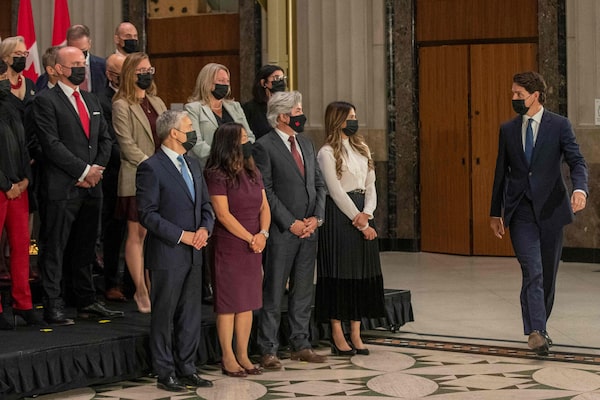
Prime Minister Justin Trudeau arrives to speak at a press conference with members of his new cabinet in Ottawa, on Oct. 26, 2021.LARS HAGBERG/AFP/Getty Images
Lori Turnbull is the director and an associate professor at the School of Public Administration at Dalhousie University.
It seems Prime Minister Justin Trudeau wants to pretend that September’s federal election never happened. Can you really blame him?
He has been criticized heavily for calling an early election that nobody wanted, with no clear ballot question, all in an overtly partisan attempt to secure a majority government he didn’t really need, given that his minority government was stable and secure. Despite encouraging polling data in the pre-campaign period, however, his snap election returned a balance of power in the House of Commons that is almost identical to what it was before dissolution.
Mr. Trudeau, however, is still seeking that majority – and to that end has maintained a “nothing to see here” attitude. There has been no sense of transition or realignment of priorities since election day – as if his government’s second mandate didn’t come to a close due to his own decision – and while a cabinet is typically sworn in within two weeks of an election, it took Mr. Trudeau more than a month to introduce his new roster of ministers, ahead of a late reconvening of Parliament on Nov. 22. It’s clear he would prefer that Canadians forget about that election in the hope that, with more time and legislative achievements, he can get the majority government he still desires.
In Justin Trudeau’s cabinets, women of colour are routinely overlooked
House of Commons redistribution proposal is a time bomb for Justin Trudeau
His 39-member cabinet, announced Tuesday, makes sense in that context. It is a get-things-done cabinet of the sort a majority government would appoint; a working, operational team, rather than a focus group, comprised of loyalists to the leader who can push through legislation in a minority Parliament. To that end, he has reserved key portfolios for trusted allies who have the parliamentary experience and communication style required for the task. Minister of Finance and Deputy Prime Minister Chrystia Freeland, for instance, remains Mr. Trudeau’s right hand. She and Minister of Employment, Workforce Development and Disability Inclusion Carla Qualtrough are frequent spokespeople for the Trudeau government who have played key roles in stabilizing the economy and the workforce during a time of great uncertainty. Moving either of them would have created a sense of change, which the Prime Minister clearly wants to avoid.
The majority of returning ministers, however, have been assigned to new portfolios – not to put a fresh face on government but to instill a sense of continuity, as if nothing has changed, while also effectively leveraging ministers’ skills and experience. For instance, Pablo Rodriguez returns to the Department of Canadian Heritage; he has the moxie needed to work with stakeholders to get beleaguered Bill C-10 on internet regulation right this time and to communicate its intent without getting bogged down in a debate about censorship. Anita Anand, who led the government’s vaccine procurement strategy, has been given the unenviable but urgent task of fixing the military. Ginette Petitpas Taylor, who was health minister before being removed from cabinet in 2019, has been brought back to take the lead on Official Languages. Many of the new ministers, including Randy Boissonnault and Sean Fraser, already have experience as parliamentary secretaries, so even they will be able to hit the ground running. There are only a few true rookies in this cabinet, and their roles are relatively junior.
By creating a get-things-done cabinet, we can expect the government’s dismissive approach to Parliament and its processes to continue. We will see fewer sitting days and diminished opportunities for government accountability. The Liberals will likely govern as though they have a majority, as the Prime Minister confirmed in a press event after the swearing-in ceremony: “With a refreshed and reinvigorated team around me,” he said, “I’m really excited about what we’re going to be able to accomplish for Canadians and I know that this team is raring to go.”
The weakness and division on the opposition side of the House will make it easy for him to ignore Parliament, particularly if Conservative Leader Erin O’Toole continues to face challenges to his leadership. However, these conditions will also make it difficult for the Liberals to call yet another early, unnecessary election. Mr. Trudeau is hoping that, by governing as if he has a majority, he can right the ship and earn that majority in the next election – potentially saving his own job in the process, before conversations about a succession plan get too loud.
Keep your Opinions sharp and informed. Get the Opinion newsletter. Sign up today.